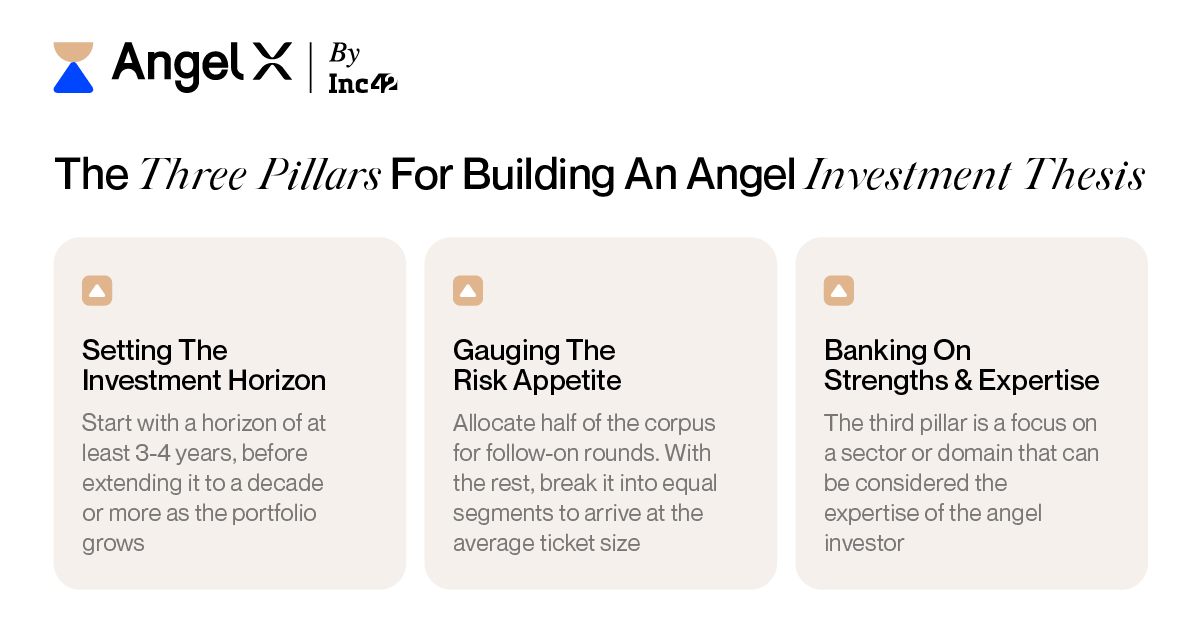Like every startup needs to focus on a core business, which is usually outlined in the vision or mission statement, the thesis will show the core focus for an angel investor
Simply put, an investment thesis is a document with three pillars or answers — the investment horizon, the risk and exposure appetite, as well as domain expertise
Given the increased competition in the angel investor space, a clear and precise thesis will enable angels to set a benchmark for themselves when it comes to future investment and enable faster decisions
“What’s the power of a thesis? It’s a living document that will not only direct you but also a partner that clears your mind. Because of my thesis, I don’t take more than five seconds. I don’t even make a decision. It’s automatic.” — Angel investor Ritesh Malik
Imagine venturing into a new city and driving around to take in the sights — it would be nearly impossible for anyone to see the relevant places of interest or even the right route without a map. We have always needed these guides to navigate new territory — whether paper or digital — and just like that an investment thesis is the compass and the GPS for angel investors.
While a lot of theorising occurs around the topic of investment thesis, the simple idea is to create a guideline or a rule book to make future decision making simpler, according to some of the most prolific angel investors in India.
Through the AngelX series, Inc42 is looking to distil these best practices for new and inexperienced individuals who are looking to back startups as angels. Through conversations with Malik, Sanjay Mehta, Rajesh Sawhney and several other angel investors in the ecosystem, the picture is becoming clearer.
What’s An Investment Thesis?
Simply put, an investment thesis is a document with three pillars or answers — the investment horizon, the risk and exposure appetite, as well as domain expertise. But as many angel investors say as one continues to back startups, these three aspects continue to evolve and therefore an investment thesis needs to be alive and breathing, so to speak.
Like 100X.VC’s Mehta puts it, “You have to revisit it continuously as the information flow comes in, as you get more and more enriched by the changing environment. There’s a standard pattern for building an investment thesis but the building blocks will always be changing.”
How To Develop An Angel Investment Thesis
Like any investment thesis, documentation is critical even if the statement evolves over time. Answer the questions in relation to the three pillars above to start with. The final statement at any given time should be clear, concise and should not use too much jargon as many first-time founders might be intimidated, and they would be the primary target audience for angel investors.
Besides being a vision document for any angel investor, a thesis is also about the branding of the investor. It’s also a signal to the wider investment community which is always looking for co-investors. More crucially, as an angel investor’s portfolio grows, the thesis will be key to minimising risk and making decisions faster.
Here’s a snapshot of the three key aspects before we dive into more details:

1. Setting The Investment Horizon
While it may sound like an abstract concept, a horizon is nothing but the number of years that any investor wants to maintain their portfolio before selling their holdings for profits. Typically speaking, newer angel investors have a narrower horizon of three-four years when they begin, as they are testing the waters and understanding the various ins and outs of the startup world.
“As you mature, you need to have at least a ten-year horizon for all your investments. That’s the only way you can practice the portfolio approach. And that’s only when you are likely to see the huge returns that you want,” says GSF Accelerator founder and angel investor Sawhney.
Sawhney saw a 25x return on its investment in Pokkt and a 50X return on DailyRounds after both startups were acquired in 2019 and 2020.
2. Gauging The Risk Appetite
“When considering the risk appetite for the thesis building, try to answer the question of what kind of capital you want to invest and when you want the liquidity,” adds Mehta.
As angel investors, the activity and the frenzy in the market can sometimes lead to loss of perspective about ticket sizes and how much to invest. The risk appetite is the aspect that is more prone to be overestimated by angel investors and this often results in investments that can be called FOMO bets, according to Malik.
His advice to new angels is to allocate half of the corpus for new deals, and the rest for follow-on rounds. Break down the portion allocated for new rounds into 20 or 30 parts and that should help angels figure out the ticket size for their deals. For a corpus of INR 1 Cr, for instance, this method would give us a ticket size of INR 2 Lakh-INR 3 Lakh per deal spread across 15-20 deals.
The risk appetite and the average ticket size will also guide angel investors on how early they want to invest.
Malik added that for new and inexperienced angels, it is typically not advised to have large cheque sizes because then they would be competing against established angels and entrepreneur-investors.
3. Banking On Strengths & Expertise
The third building block in any investment thesis is the sector or the domain that the angel investor is confident about. Those coming from CXO backgrounds can use their expertise in management and problem-solving to help founders in a fix, which can be more valuable than capital at times.
But the sector or domain focus is necessary in the beginning — not just to assess potential pitches, but also to find deals. It also allows the angel investor time to take decisions faster and apportion significant time in learning about newer domains, believes Sawhney.
He added that often new angel investors or family offices tend to get lost in conceptual ideas such as founder-first mentality or looking for impactful ideas, that they forget the discipline that goes into thesis building, and the fundamentals.
Like every startup needs to focus on a core business, which is usually outlined in the vision or mission statement, the thesis will show the core focus for an angel investor
Why Make An Investment Thesis?
Over the years, the contribution of angel investors in early-stage startups has become irreplaceable and irrefutable. And the real upside is being seen by those investors who are backing promising startups early, given that the rate at which valuations have multiplied has also grown. The pace of unicorn creation is a major indicator about the real upside for angels — the median time to unicorn has reduced to six years amid this boom.
According to Inc42 data, over 950+ angel and individual investors participated in Indian startup funding since 2014 and this pool is about to grow bigger as more and more HNIs and executives turn into angels. Besides this, unicorn founders such as Sujeet Kumar, Gaurav Munjal, Vidit Aatrey, Varun Alagh, and Sahil Barua were also among the most active angel investors in 2021.
Given this competition, a clear and precise thesis will enable angel investors to set a benchmark for themselves when it comes to future investments, and minimise risk or reckless investments, which can crop up when there are too many investors in the market.

































 Ad-lite browsing experience
Ad-lite browsing experience